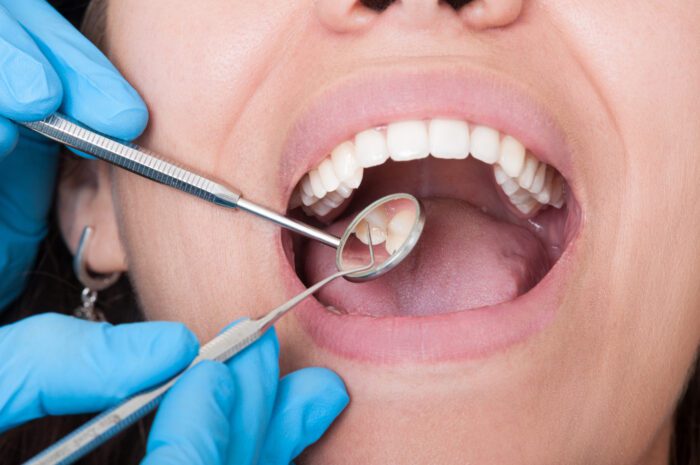Dental fillings are a conservative treatment that will restore a tooth with a cavity or tooth decay. Dentists rely on this treatment to protect natural teeth from further problems once a tooth has been compromised by decay. Infinity Dental offers a range of dental fillings in Fox Lake, IL to treat tooth damage.

Types of Dental Fillings in Fox Lake, IL
Resin Dental Fillings
Resin dental fillings come in a range of tooth-colored shades, matching the look of your teeth almost perfectly. This procedure is also known as cosmetic bonding because the resin is bonded directly to the tooth. In most cases, dentists can place composite resin dental fillings in a single visit.
Benefits of composite dental fillings:
- Good durability for long-lasting results
- Environmentally friendly and non-toxic
- Made of bio-compatible materials
- Bonded directly to the tooth, making them stronger when compared to amalgam
- Require little to no tooth preparation
- Virtually indistinguishable from natural tooth structure
- Available in a rainbow of tooth-colored shades
Porcelain Dental Fillings
Dentists use porcelain dental fillings, also called inlays or onlays, in patients with more advanced tooth decay or damage in larger teeth. These types of fillings add strength to the tooth similar to a dental crown. Porcelain fillings are comfortable and durable and with proper care can be very long-lasting.
Dr. Prendergast places dental fillings for adults and children to restore and stabilize the health of the tooth.
Do you place fillings in baby teeth?
Yes, the dentist will use a dental filling on a primary tooth if it has a cavity or decay. Removing infected tooth structure and placing a filling is important for several reasons:
- Reduces the spread of decay and infection to other parts of the tooth or neighboring tissue which could present a health risk if left untreated.
- Keeping baby teeth in place supports the growth and development of healthy permanent teeth and your child’s natural speech.
Inlays and Onlays
Inlays and onlays are used when you need more than a filling, but you don’t need a complete dental crown. Dentists use inlays when a large amount of decay impacts the chewing surface of a tooth. Using stronger materials than a filling, an inlay will fit into the hollow of your tooth, but it won’t impact the cusps of the tooth. It provides more support and strength to the tooth than a filling can.
Onlays are similar, however, they’re used on both the biting surface and the cusps of your tooth. Onlays are also called partial crowns because they perform the same kind of function. They allow you to keep more of your natural tooth structure, instead of your dentist filing down the tooth to accommodate a full dental crown.
A dental filling treatment is fairly simple and your dentist can complete it in one brief visit to our dental office in Fox Lake. We will use a topical anesthetic to numb the area. Once you are comfortable, the dentist will remove the infected and damaged part of the tooth and clean it to prepare for the filling.
Dr. Prendergast will carefully sculpt the filling material into place in the case of composite resin and permanently seal it using a special blue light. If you are getting an inlay or onlay, we will take impressions for the dental lab to use when making your custom ceramic restoration.
We will place a temporary restoration to protect the tooth until the final one is complete. You can then schedule your second visit to place the inlay or onlay and seal the tooth.
Dental Fillings FAQs
What do I do if my dental filling broke?
If you have a broken dental filling or missing dental filling, it is important to contact our office as quickly as possible. We reserve time throughout the day for our dentists to treat dental emergencies such as lost or broken dental fillings.
Do not attempt to temporarily secure your dental filling with glue or other adhesive. Avoid foods that may become trapped in the tooth hole and continue to brush the tooth carefully to avoid a build-up of plaque, food, and other debris.
Can I eat after a filling?
After a filling patients should avoid chewing for a few hours to let the numbing wear off. Patients can drink about an hour after the procedure, but chewing puts patients at risk to bite their gum or lip due to the numbing. Patients should not eat or drink anything 2 hours prior to their filling appointment.
Can I drink water after a filling?
Patients should wait at least an hour to let their filling set before drinking anything. Water should not affect your filling from curing, but it is best to wait to be safe.
How can I strengthen my teeth naturally?
Patients can attempt to strengthen teeth naturally by flossing and practicing a more involved oral care routine. Avoiding smoking as well as using a fluoride-based toothpaste will also help strengthen teeth.
How much do dental fillings cost?
The cost of your dental fillings will depend on how many fillings you require, the severity of the cavity or tooth damage, and the materials used in your filling. During a consultation in our office, we will discuss the estimated cost of your treatment and ensure that it matches your budget.
Can dental fillings fall out?
Fillings can fall out of your mouth if you experience tooth decay or sustain a dental injury. The material that bonds dental fillings to teeth may loosen over many years. Please get in touch with our office if you have lost our filling. We can provide you with a replacement to protect your tooth.
If you have a broken filling or suspect you may have a cavity, contact Infinity Dental of Fox Lake to schedule an appointment with one of our dentists.
